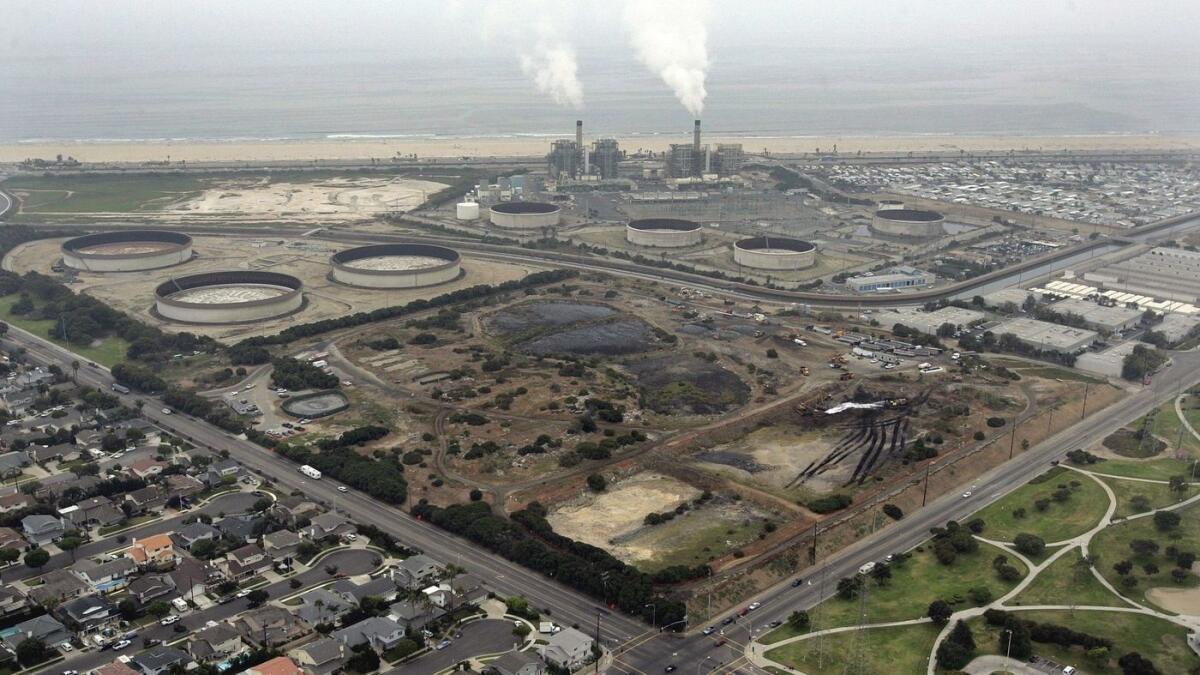Residents air concerns about dust, odors, traffic and health effects of upcoming cleanup at former Ascon Landfill

- Share via
State employees and project managers for a cleanup project at the former Ascon Landfill in Huntington Beach addressed community concerns at a public gathering Thursday night.
About 20 people showed up at Edison High School for the meeting, presented by the California Department of Toxic Substances Control and representatives of the property owner.
The 38-acre property at the southwest corner of Hamilton Avenue and Magnolia Street was a waste disposal facility from about 1938 to 1984. Much of the waste came from oil drilling until 1971, when the landfill became a depository for construction debris, according to the project’s website.
Efforts to improve the area, which is designated as a federal Superfund site for cleanup of hazardous pollutants, began after the state demanded cleanup of the property’s five waste-filled lagoons and six oil wells in 2003. In 2017, the Huntington Beach Planning Commission granted property owner Cannery Hamilton Properties a development permit for abandonment of two oil wells beneath one of the five lagoons.
In September this year, the commission granted coastal development and conditional use permits needed to begin an estimated 18-month cleanup, called the Final Remedy, including excavating a portion of the contaminated materials at the site.
Plans include capping the remaining waste with drought-tolerant vegetation and adding two stormwater detention basins.
Work is expected to begin in January. Oversight will come primarily from the Department of Toxic Substances Control.
Speakers at Thursday’s meeting raised concerns about odors and chemical emissions, dust migrating into residential areas, traffic caused by trucks, and exposure risks for students at Edison High, which is northeast of the Magnolia-Hamilton intersection, making it immediately upwind of the former landfill, engineers said.
“If I was a parent of a child at this school, my butt would be here,” a community member said while viewing posters about the project in the Edison cafeteria.
Project management personnel said the landscape of the former landfill is highly variable and doesn’t allow rainwater to drain adequately, creating the potential for water to seep into the waste material, where it can become contaminated before entering groundwater.
Plans call for moving tons of waste to create a dome-like landscape that will be sealed with an engineered cap covered by drought-tolerant vegetation. The design will channel rainwater to the perimeter of the property, where it will be collected by the city’s storm drain system, officials said.
“Why not cap it right where it is?” asked Huntington Beach resident Rondda Reid, who asked if there were less disruptive ways to channel rainwater than moving waste around. “Why disrupt it?” she said.
About 160,000 tons, or 120,000 cubic yards, of waste have already been removed from the property in two cleanup operations since 2005.
Project managers estimate the final stage will remove an additional 5,000 cubic yards of waste in the process of consolidating materials to change the topography. It could be as many as 32,000 cubic yards.
A resident questioned whether trucks would disrupt traffic around Edison High.
Maps show proposed routes don’t pass the school. Another speaker said he lived next to a truck route during previous removal operations and didn’t feel that traffic was seriously affected.
An estimated 20 to 25 trucks a day will be removing waste, though many more — about 100 to 150 per day — will be bringing in new soil, according to project management.
Covered trucks will haul waste to a permitted hazardous-waste facility four hours north of Huntington Beach, said Tamara Zeier of Project Navigator, the project manager for Cannery Hamilton Properties.
During the planning process, proposals ranged from no waste removal to total removal, which would amount to a little over 1 million cubic yards, Zeier said.
All the latest on Orange County from Orange County.
Get our free TimesOC newsletter.
You may occasionally receive promotional content from the Daily Pilot.







